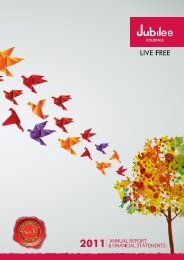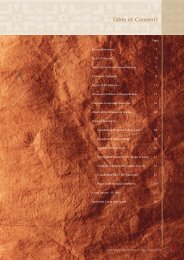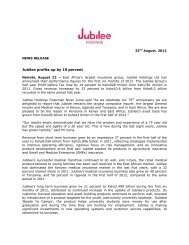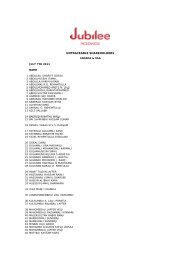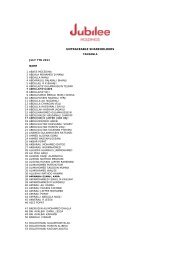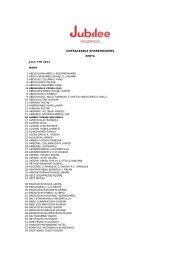Jubilee Insurance 2010 Annual Report
Jubilee Insurance 2010 Annual Report
Jubilee Insurance 2010 Annual Report
You also want an ePaper? Increase the reach of your titles
YUMPU automatically turns print PDFs into web optimized ePapers that Google loves.
JUBILEE HOLDINGS<br />
ANNUAL REPORT AND FINANCIAL STATEMENTS<br />
FOR THE YEAR ENDED 31 ST DECEMBER <strong>2010</strong><br />
21<br />
NOTES<br />
1. General Information<br />
<strong>Jubilee</strong> Holdings Limited is a limited liability company incorporated<br />
and domiciled in Kenya. The address of its registered office is: <strong>Jubilee</strong><br />
<strong>Insurance</strong> House, Wabera Street, Nairobi, Kenya. The company has a<br />
primary listing on the Nairobi Stock Exchange and is cross-listed on the<br />
Uganda Securities Exchange and Tanzania.<br />
The Company through its subsidiaries and associates (together forming<br />
the Group) underwrites Life and non-life insurance risks, such as those<br />
associated with death, disability, health, property and liability. The Group<br />
also issues a diversified portfolio of investment contracts to provide<br />
its customers with asset management solutions for their savings and<br />
retirement needs. All these products are offered to both domestic and<br />
foreign markets. It has operations in Kenya, Uganda, Tanzania, Burundi<br />
and Mauritius and employs over 400 people through its subsidiaries.<br />
The insurance business of the Group is organized into two main divisions,<br />
short-term (general) business and long-term (life) business. Long-term<br />
business relates to the underwriting of life risks relating to insured persons,<br />
the issue of investment contracts and the administration of pension funds.<br />
Short-term business relates to all other categories of insurance business<br />
written by the Group, analysed into several sub-classes of business based<br />
on the nature of the assumed risks.<br />
With a view to diversifying the Group’s income base, operational<br />
activities have been extended to include fund management, property<br />
development and management, power generation and international fibre<br />
optic broadband cable connectivity.<br />
For purposes of the Kenya Companies Act reporting purposes, the<br />
balance sheet is represented by statement of financial position while the<br />
profit and loss account is represented by the income statement.<br />
2. Summary of significant Accounting Policies<br />
The principal accounting policies adopted in the preparation of<br />
these financial statements are set out below. These policies have been<br />
consistently applied to all years presented, unless otherwise stated.<br />
2.1 Basis of Preparation<br />
The financial statements are prepared in compliance with International<br />
Financial <strong>Report</strong>ing Standards (IFRS). The measurement basis applied is<br />
the historical cost basis, except where otherwise stated in the accounting<br />
policies below. The financial statements are presented in Kenya Shillings<br />
(Shs), rounded to the nearest thousand.<br />
(i) Standards, amendments and interpretations to existing standards<br />
effective in <strong>2010</strong> but not relevant<br />
Amendments to IFRS 2: Group cash-settled share-based payment<br />
transactions – effective 1 January <strong>2010</strong>. The amendment clarifies the<br />
accounting for group cash-settled share-based payment transactions.<br />
The entity receiving the goods or services shall measure the share-based<br />
payment transaction as equity-settled only when the awards granted<br />
are its own equity instruments, or the entity has no obligation to settle<br />
the share-based payment transaction. The entity settling a share-based<br />
payment transaction when another entity in the group receives the goods<br />
or services recognises the transaction as equity-settled only if it is settled in<br />
its own equity instruments. In all other cases, the transaction is accounted<br />
for as cash-settled.<br />
IFRS 3 Business Combinations – Revised – effective 1 July 2009. The<br />
new standard continues to apply the acquisition method to business<br />
combinations, with some significant changes. For example, all payments<br />
to purchase a business are to be recorded at fair value at the acquisition<br />
date, with some contingent payments subsequently re-measured at fair<br />
value through income. Goodwill may be calculated based on the parent’s<br />
share of net assets or it may include goodwill related to the minority<br />
interest. All transaction costs will be expensed.<br />
IAS 27 Consolidated and Separate Financial Statements – Revised<br />
– effective 1 July 2009. IAS 27 (revised) requires the effects of all<br />
transactions with non-controlling interests to be recorded in equity if there<br />
is no change in control. They will no longer result in goodwill or gains and<br />
losses. The standard also specifies the accounting when control is lost.<br />
Any remaining interest in the entity is re-measured to fair value and a gain<br />
or loss is recognised in profit or loss.<br />
Amendments to IAS 39 Financial Instruments: Recognition and<br />
Measurement Eligible Hedged Items – effective 1 July 2009. The<br />
amendment makes two significant changes. It prohibits designating<br />
inflation as a hedgeable component of a fixed rate debt. It also prohibits<br />
including time value in the one-sided hedged risk when designating<br />
options as hedges.<br />
IFRIC 17 Distributions of Non-cash Assets to Owners – effective 1 July<br />
2009. IFRIC 17 applies to the accounting for distributions of non-cash<br />
assets (commonly referred to as dividends in specie) to the owners of<br />
the entity. The interpretation clarifies that: a dividend payable should<br />
be recognised when the dividend is appropriately authorised and is<br />
no longer at the discretion of the entity; an entity should measure the<br />
dividend payable at the fair value of the net assets to be distributed; and<br />
an entity should recognise the difference between the dividend paid and<br />
the carrying amount of the net assets distributed in profit or loss.<br />
IFRIC 18 Transfers of assets from customers - effective for periods<br />
beginning 1 July 2009. This interpretation clarifies the requirements<br />
of IFRSs for agreements in which an entity receives from a customer<br />
an item of property, plant and equipment that the entity must then use<br />
either to connect the customer to a network or to provide the customer<br />
with ongoing access to a supply of goods or services (such as a supply<br />
of electricity, gas or water). This interpretation does not impact on the<br />
Group’s financial statements.<br />
(ii) Standards, amendments and interpretations to existing standards that<br />
are not yet effective and have not been early adopted by the Group<br />
IAS 24 (Revised) ‘Related party disclosures’ – effective 1 January<br />
2011. The revised standard clarifies and simplifies the definition of a<br />
related party and removes the requirement for government-related<br />
entities to disclose details of all transactions with the government and<br />
other government-related entities. When the revised standard is applied,<br />
the company will need to disclose any transactions between itself and<br />
associates of its parent company. The Group is currently putting systems<br />
in place to capture the necessary information. It is, therefore, not possible<br />
at this stage to disclose the impact, if any, of the revised standard on the<br />
related party disclosures.<br />
Classification of rights issues’ (amendment to IAS 32) – effective 1<br />
February <strong>2010</strong>. The amendment addresses the accounting for rights<br />
issues that are denominated in a currency other than the functional<br />
currency of the issuer. Provided certain conditions are met, such<br />
rights issues are now classified as equity regardless of the currency in<br />
which the exercise price is denominated. Previously, these issues had<br />
to be accounted for as derivative liabilities. The amendment applies<br />
retrospectively in accordance with IAS 8 ‘Accounting policies, changes<br />
in accounting estimates and errors’. This amendment is not expected to<br />
have any impact on the Group’s financial statements.<br />
IFRIC 19, ‘Extinguishing financial liabilities with equity instruments’ -<br />
effective 1 July <strong>2010</strong>. The interpretation clarifies the accounting by<br />
an entity when the terms of a financial liability are renegotiated and<br />
result in the entity issuing equity instruments to a creditor of the entity<br />
to extinguish all or part of the financial liability (debt for equity swap).<br />
It requires a gain or loss to be recognised in profit or loss, which is<br />
measured as the difference between the carrying amount of the financial<br />
liability and the fair value of the equity instruments issued. If the fair<br />
value of the equity instruments issued cannot be reliably measured, the<br />
equity instruments should be measured to reflect the fair value of the<br />
financial liability extinguished. It is not expected to have any impact on<br />
the Group’s financial statements.<br />
JUBILEE HOLDINGS



